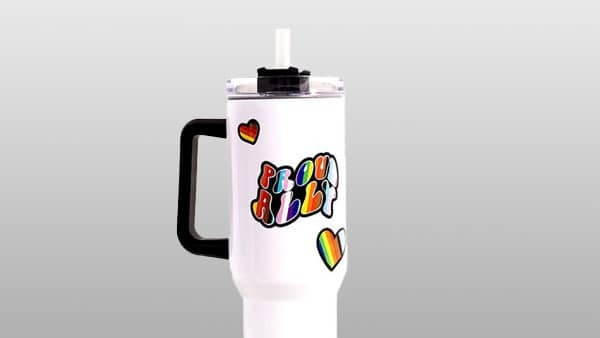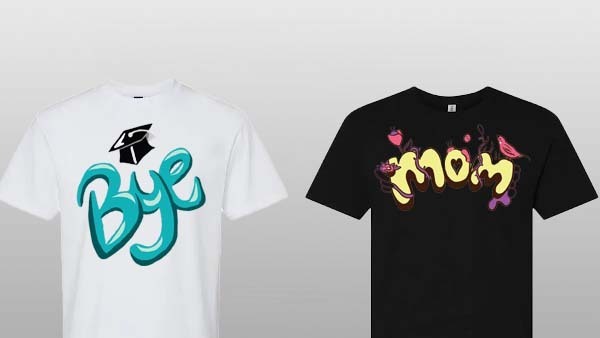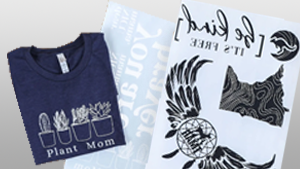Since its invention, printing has been making life a lot easier. When you need a copy of something, a printer is quite a bit more convenient than tracking down some scholarly monk and convincing them to transcribe it by hand. Printers can also add ease into making designs for all your decorating needs, and, conveniently, there are a couple options available– heat transfer paper and sublimation printing. But which one to choose? Though similar in principle, there are some key differences between the use of heat transfer paper and sublimation inks, and, by golly, we’ll discuss them below.
Heat Transfer Paper
Part of the beauty of heat transfer paper lies in its simplicity– print an image that you’ve designed on your computer, then use a heat press to apply it to a garment, and that’s it! It can work with your basic inkjet or laser printer, so if you have one of those, all you’ll need is a heat press (like our WALAPress 16x20) and the heat transfer paper itself (like our WALAPaper Inkjet Light or Dark), which makes the startup cost of this method relatively low. On top of that, heat transfer paper can be used on both cotton and polyester garments, and on colors ranging from light to dark. There are a few factors to consider, though.
Designs applied with heat transfer paper do add a thin layer on top of the fabric to which it is being pressed and will need to be trimmed around the design or the outline of the untrimmed paper will be visible. There are also self-weeding two-step papers available, like Forever Laser Dark and Forever Laser Light, which will transfer only the printed image with no cutting necessary.
Some things to consider– since it is a layer applied to the surface of the fabric, transfers using this method can eventually crack and wear down after some use/washes, so it is less durable than designs transferred with sublimation ink. If printing full-color pictures (say, for a company logo), heat transfer paper may be a bit less specific in the colors that you can achieve than sublimation inks would. Finally, heat transfer paper works well on garments and fabric, but does not work well on hard surfaces, so if that’s something you are looking to do, heat transfer paper might not be the right option.
Sublimation Transfers
Sublimation inks are also a wonderful and fairly simple thing, but they have a little more scientific intrigue tied in with how they work. As opposed to applying a design with paper with a backing, this method uses a sublimation printer and ink to print an image onto specialized paper, then, when heated and pressed, the sublimation ink turns from a solid into a gas, and the molecules fuse into the garment, returning to a solid state when cool again. While definitely pretty nifty in terms of just being scientifically cool, this also makes sublimated designs very durable, as they have become a part of the fabric or poly-coating itself.
Sublimation inks can also be used to transfer full-color images with a great degree of accuracy, and, as another added bonus, can be applied to any hard surface with a poly-coating, making it possible to decorate blank mugs, tumblers, photo panels, and similar items that have been specifically designed for sublimation.
Sublimation inks do have a few limitations since they will only bond with polyester, so no 100% cotton garments for this method. They can work on some poly/cotton blends, but the transfer will not be quite as vivid. Another consequence of the ink bonding directly into the fabric is that sublimation inks will not show up well on dark-colored fabrics, so they are limited to white or light-colored ones.
The price point of the sublimation process is also something to consider– it requires a sublimation printer (like the Sawgrass SG500), sublimation inks, and sublimation paper, on top of the heat press you will need to apply the design, so it is a bit higher cost to use sublimation when compared to heat transfer paper. You can find further ideas on recouping your investment in sublimation here.
Conclusion
The breakdown? While both are great options, heat transfer paper is inexpensive, easy, and is versatile in its ability to be applied to light and dark fabrics, whether they be cotton or polyester. However, it lacks the durability and color-specificity of sublimation. Sublimation is vivid and durable, but it has more expensive startup costs and is limited in its ability to only be applied to polyester and poly-coating. So which is right for you? The choice is yours, but whatever you decide, rest assured your results will live up to your colorful and creative standards.

 Custom Printed Apparel
Custom Printed Apparel Custom DTF Apparel
Custom DTF Apparel Embroidered Apparel
Embroidered Apparel
 Full Service Customization
Full Service Customization Rhinestone Apparel
Rhinestone Apparel
 Sublimated Apparel
Sublimated Apparel
 Custom Drinkware/Photo Panels
Custom Drinkware/Photo Panels Siser Sanmar Decoration
Siser Sanmar Decoration Seasonal Items
Seasonal Items DTF Transfers
DTF Transfers
 Supacolor Transfers
Supacolor Transfers
 Sublimation Transfers
Sublimation Transfers
 Rhinestone Transfers
Rhinestone Transfers
 HTV Transfers
HTV Transfers
 Custom Patches, Stickers, & Magnets
Custom Patches, Stickers, & Magnets Custom Screen Print Transfers
Custom Screen Print Transfers Artwork & Services
Artwork & Services
 Custom Banners
Custom Banners